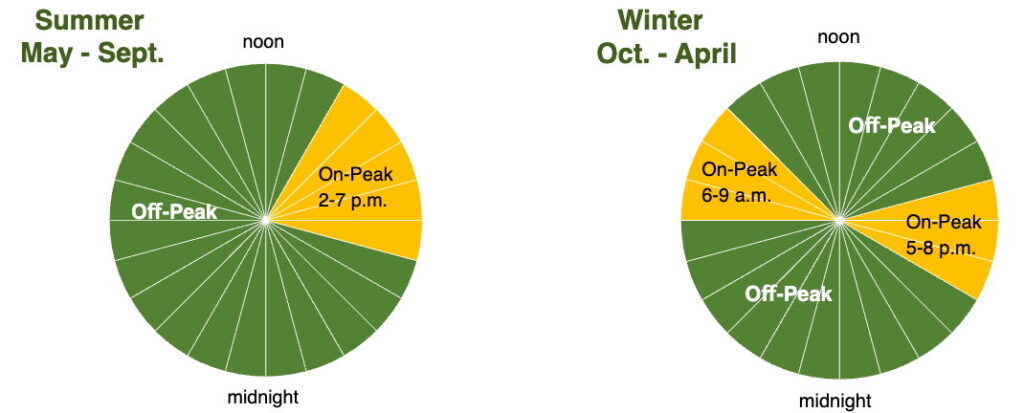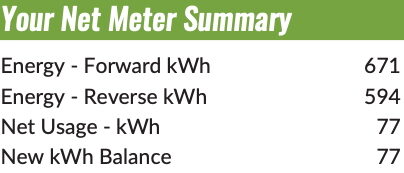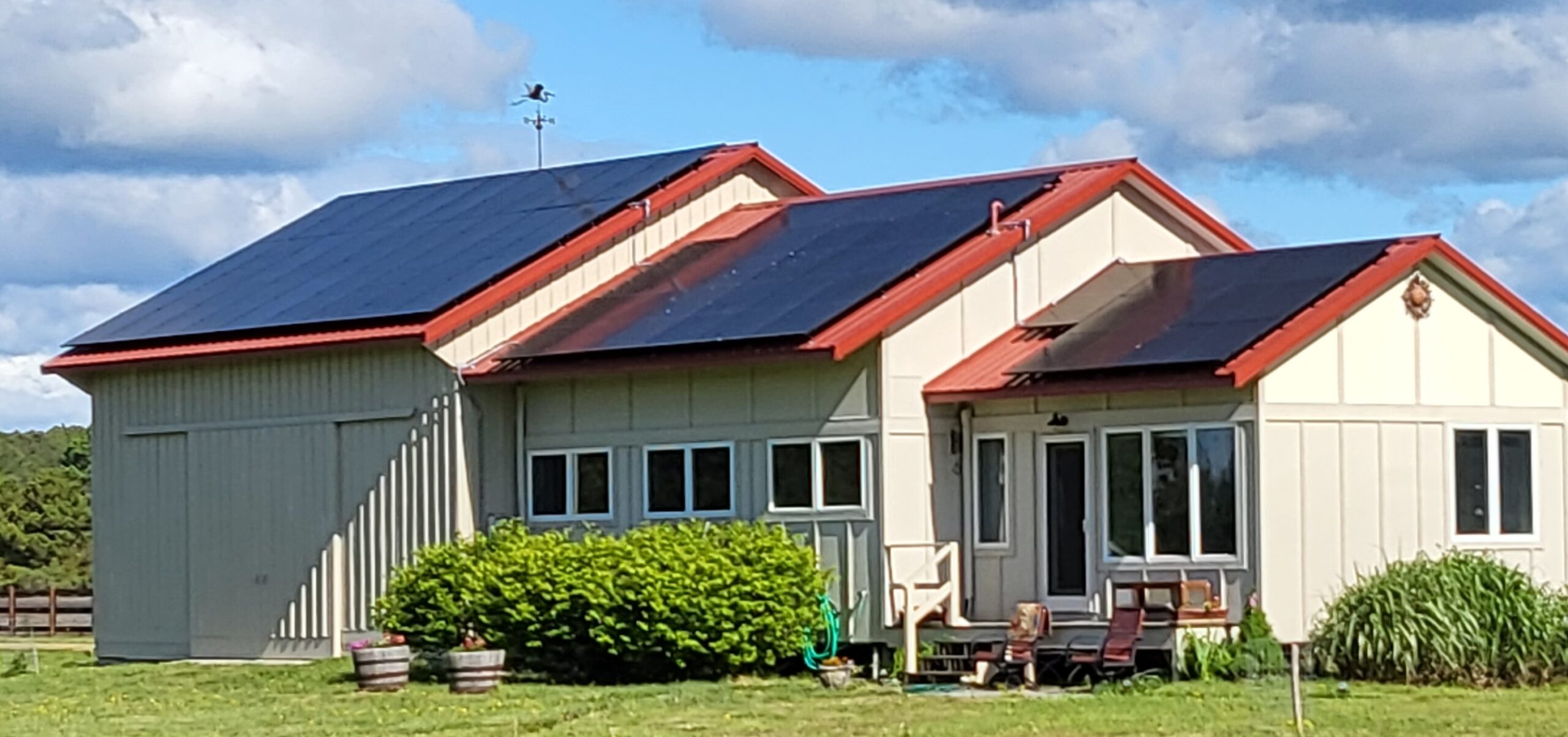The Time-of-Use (TOU) billing plan offers Southern Maryland Electric Cooperative (SMECO) members with solar a powerful opportunity to further reduce their electricity costs. While available to all members, this optional rate structure offers unique advantages that align perfectly with the nature of solar generation. This guide will break down what the TOU rate is, how it works with your solar, and why making the switch is a strategic move for maximizing your savings.
What is Time-of-Use Billing?
Time-of-Use is an alternative rate structure that moves away from the single, flat rate of the default Standard Offer of Service (SOS). Instead of paying one price for electricity regardless of when you use it, the TOU plan establishes two distinct rates based on demand:
- On-Peak Hours: A higher rate charged during periods of high electricity demand.
- Off-Peak Hours: A lower rate charged during all other times.
As of this writing, SMECO defines these periods as:
- Summer (June-Sept): On-Peak is 2:00 PM – 7:00 PM on weekdays.
- Winter (Oct-May): On-Peak is 6:00 AM – 9:00 AM and 5:00 PM – 8:00 PM on weekdays.
- All weekends and major holidays are always Off-Peak.

Your smart meter automatically tracks your usage during these periods, and the charges will be clearly itemized on your monthly SMECO bill.

The Financial Difference
The core principle of TOU is that the On-Peak rate is higher than the standard SOS rate, while the Off-Peak rate is significantly lower. Rates fluctuate monthly, but to illustrate the difference, let’s use the figures from June 1, 2025:
- Standard SOS Rate: $0.10948 per kWh
- TOU On-Peak Rate: $0.2068 per kWh
- TOU Off-Peak Rate: $0.0768 per kWh
Let’s see how this impacts a customer using 2,000 kWh in a month without solar:
Example 1: Standard SOS Billing
- Calculation: 2,000 kWh * $0.10948 per kWh = $218.96
Example 2: TOU Billing with High Peak Usage
- Scenario: 700 kWh On-Peak, 1,300 kWh Off-Peak
- On-Peak Cost: 700 kWh * $0.2068 = $144.76
- Off-Peak Cost: 1,300 kWh * $0.0768 = $99.84
- Total Cost: $244.60
Example 3: TOU Billing with Low Peak Usage
- Scenario: 200 kWh On-Peak, 1,800 kWh Off-Peak
- On-Peak Cost: 200 kWh * $0.2068 = $41.36
- Off-Peak Cost: 1,800 kWh * $0.0768 = $138.24
- Total Cost: $179.60
As these examples show, for a typical household, saving money on TOU requires a conscious effort to shift heavy energy use (like running the dishwasher, laundry, or pre-cooling the home) to Off-Peak hours—a task that can be difficult to manage consistently.
However, for solar owners, this dynamic changes completely.
How Solar Makes TOU the Clear Choice
Your solar panel system fundamentally alters the TOU equation. With solar, all the energy you push to the grid is tracked through your meter, which acts like a credit bank for your account. At the end of each billing cycle, the credits your system creates are used to offset your energy usage charges in a specific order:
- On-Peak Offset First: The energy your system sends to the grid is first used to eliminate your most expensive On-Peak charges. If you generate enough solar during the day to cover your On-Peak usage, you will not be billed for any of that high-cost power.
- Off-Peak Offset Second: Any solar credits remaining after your On-Peak charges are zeroed out are then applied to your Off-Peak usage.
- Any Energy Leftover: If your solar credits cover your entire month’s usage, any surplus is rolled forward as a credit for you to use in future billing cycles and the process begins again.
In short, your solar credits systematically reduce your bill by targeting the most expensive energy rates first. Any surplus generation is always carried over to benefit you in the future.
The official verbiage can be found in SMECO’s Net Metering Policy, found here.
Real-World Example: In April 2025, a solar homeowner sent 594 kWh (Reverse kWh) to the grid and used 671 kWh (Forward kWh), meaning they had a net usage of 77 kWh. For more details on a bill with solar, see here.

Because their solar production completely eliminated their On-Peak charges, they were only billed for those 77 kWh at the low Off-Peak rate of $0.07032 per kWh. Compared to the standard April SOS rate of $0.109408 per kWh, this resulted in an energy charge savings of over 33%.

What If My System Already Covers My Entire Bill?
Even if your solar system produces more energy than you consume (overproduction), we still recommend switching to the Time-of-Use rate. If your bill is already zeroed out, your choice of rate plan won’t change your monthly charge from SMECO and you will only have a flat connection charge every month from SMECO.
However, switching provides a valuable layer of protection for the future. It’s a proactive “set it and forget it” strategy that safeguards you against:
- System Degradation: All solar panels slowly produce less power over their 25+ year lifetime. The TOU rate ensures you are always getting the maximum value for every kilowatt-hour you produce, even if you are not overproducing.
- Increased Energy Usage: Many homeowners experience the “Rebound Effect,” an unintentional increase in energy consumption after installing solar. It stems from a shift where self-generated power is viewed as an abundant resource, leading to greater use of electricity or the addition of new electrical loads like an EV charger. The TOU rate provides a buffer against these potential increases.
How to Sign Up
Making the switch is simple. You can enroll in the Time-of-Use rate on SMECO’s website here. You will only need your SMECO account number, name, and email to complete the form.
Questions? We Can Help.
At Energy Select, we pride ourselves on our understanding of energy. Having served SMECO members for over 20 years, we love helping our Southern Maryland neighbors save money, whether it’s through a new solar installation or conservation measures like optimizing a rate plan. If you have any questions, please don’t hesitate to reach out to our team.


